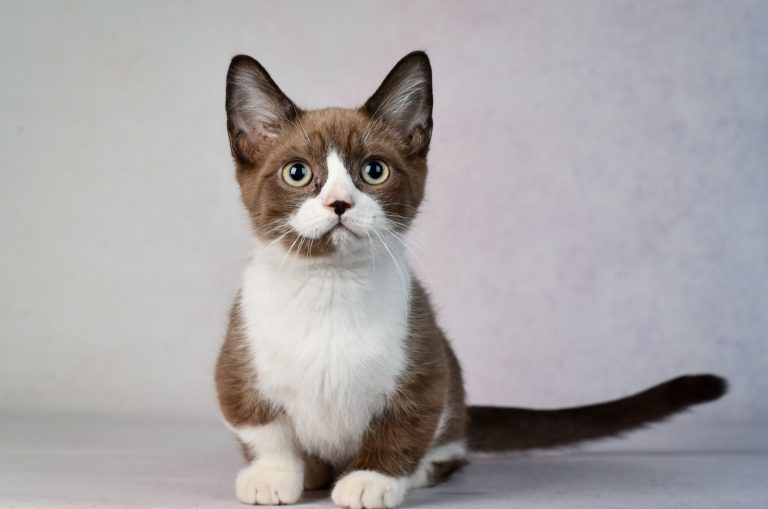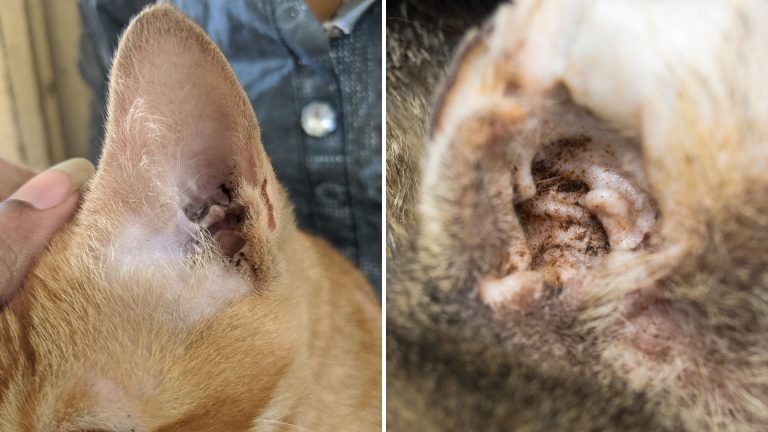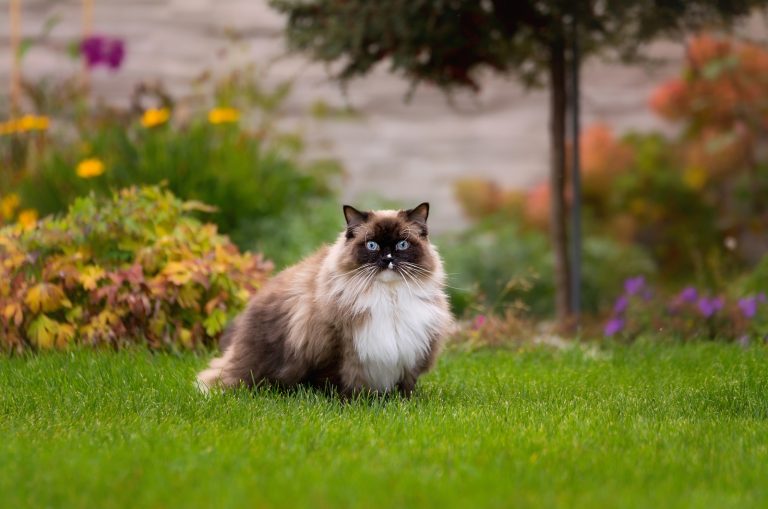Blood In Cat Stool But Acting Normal: Causes & Treatment
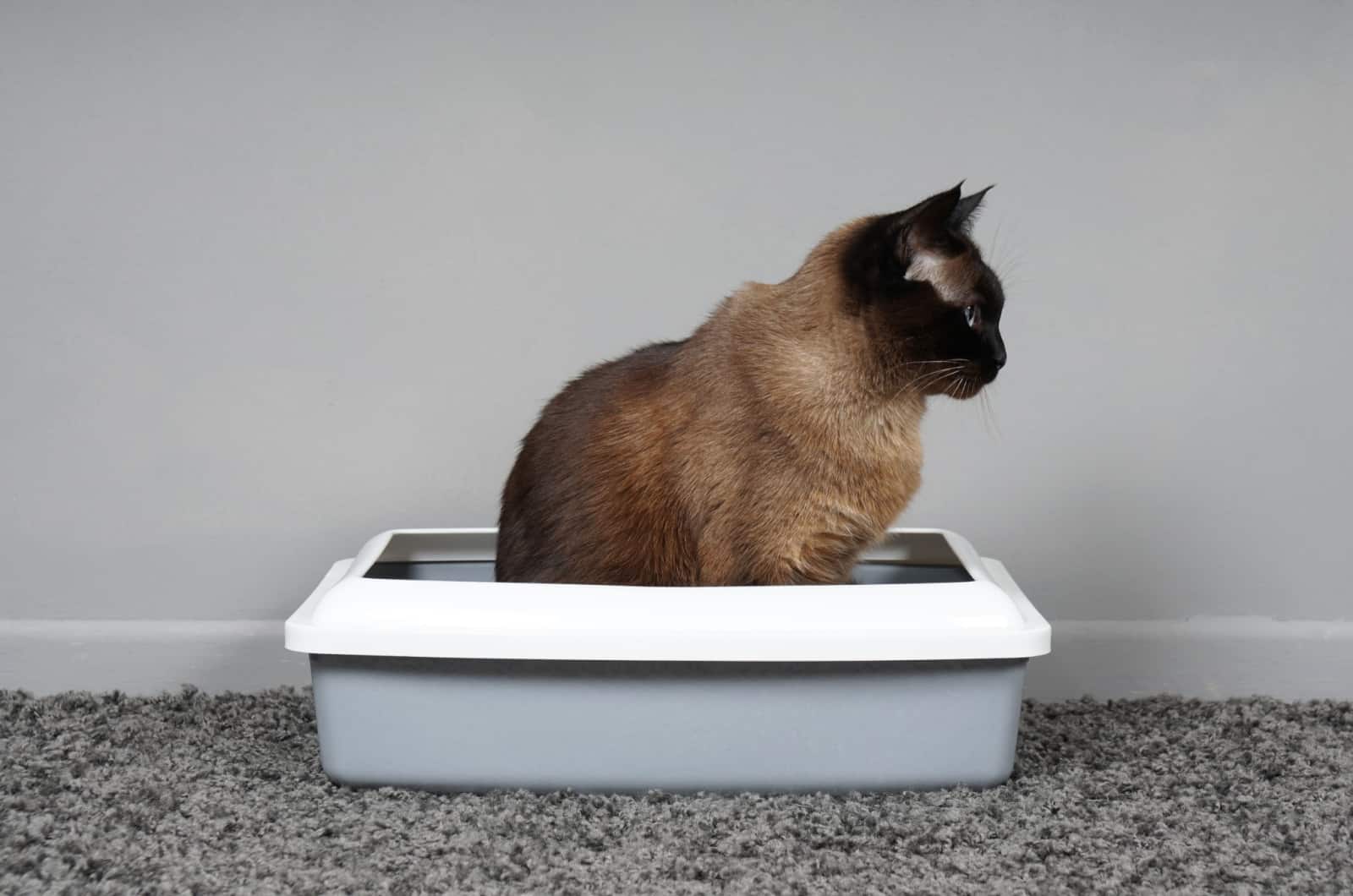
Cat owners are quick to notice when their cat’s litter habits change or their stool/urine looks unusual. Of course, it is extremely important to take note of any changes in your cat’s wellbeing, so that any potential health issues can be investigated and treated as soon as possible.
If you notice your cat has bloody stool, you need to know that this can be a sign of a serious underlying health issue that your cat is battling with, so you might need to visit a vet.
Thereare many potential causes of blood in a cat’s stool, including intestinal ulcers, intestinal blockage, anal gland infection, intestinal parasites, intestinal polyps, cancer, and many others.
There is one thing you must note: Blood in your cat’s stool is not normal! Don’t be fooled if your cat is acting normal.
Seeing blood in a cat stool when the cat is otherwise acting normal is not uncommon and the reason for this is simple. Cats are known to be able to hide their health issues very well. It is your job as a pet parent to monitor any signs your kitty is unwell, and try to help them.
If you want to learn more about what might be causing blood in the cat stool and what treatment options there may be, then I suggest you continue reading!
Blood In Cat Stool But Acting Normal: Should You Be Worried?
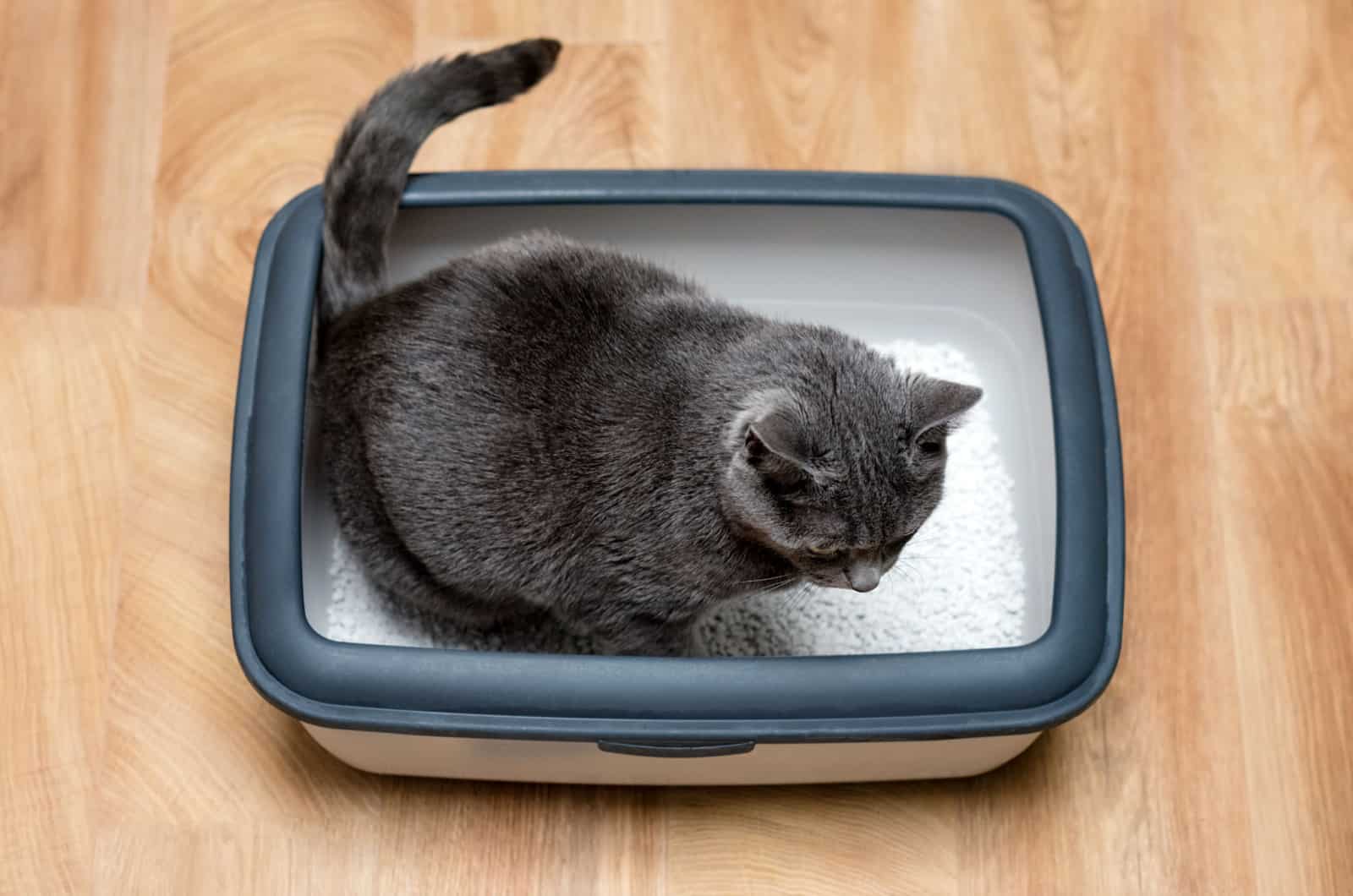
If you notice there’s blood in your cat’s stool, it is usually a sign your cat has a medical issue that needs veterinary care. It is not recommended to “wait it out” and “see what happens”.
You can usually wait a day or two for a vet appointment if your cat’s stool appears to be fairly normal with only a small amount of bright red blood and your cat isn’t experiencing any other symptoms.
Dark red or brown blood in a cat stool necessitates a more urgent trip to the veterinary clinic. Your cat should be seen right away as there is a risk that your cat is experiencing a serious health emergency.
Some potential causes of your kitty’s issue do not pose a huge risk to your cat’s health and are easily treatable. Unfortunately, other causes of bloody stool are extremely dangerous and even life-threatening.
Your cat may experience no other symptoms, or other symptoms can arise in the days after you notice the blood. Remember that your cat may be experiencing other symptoms but hiding them from you.
Whether your cat has bright red blood or brown blood in its stool, and whether it is having other symptoms or appears well – either way, you need to see a vet!
Two Types Of Bloody Cat Stools – Bright Red & Dark Red
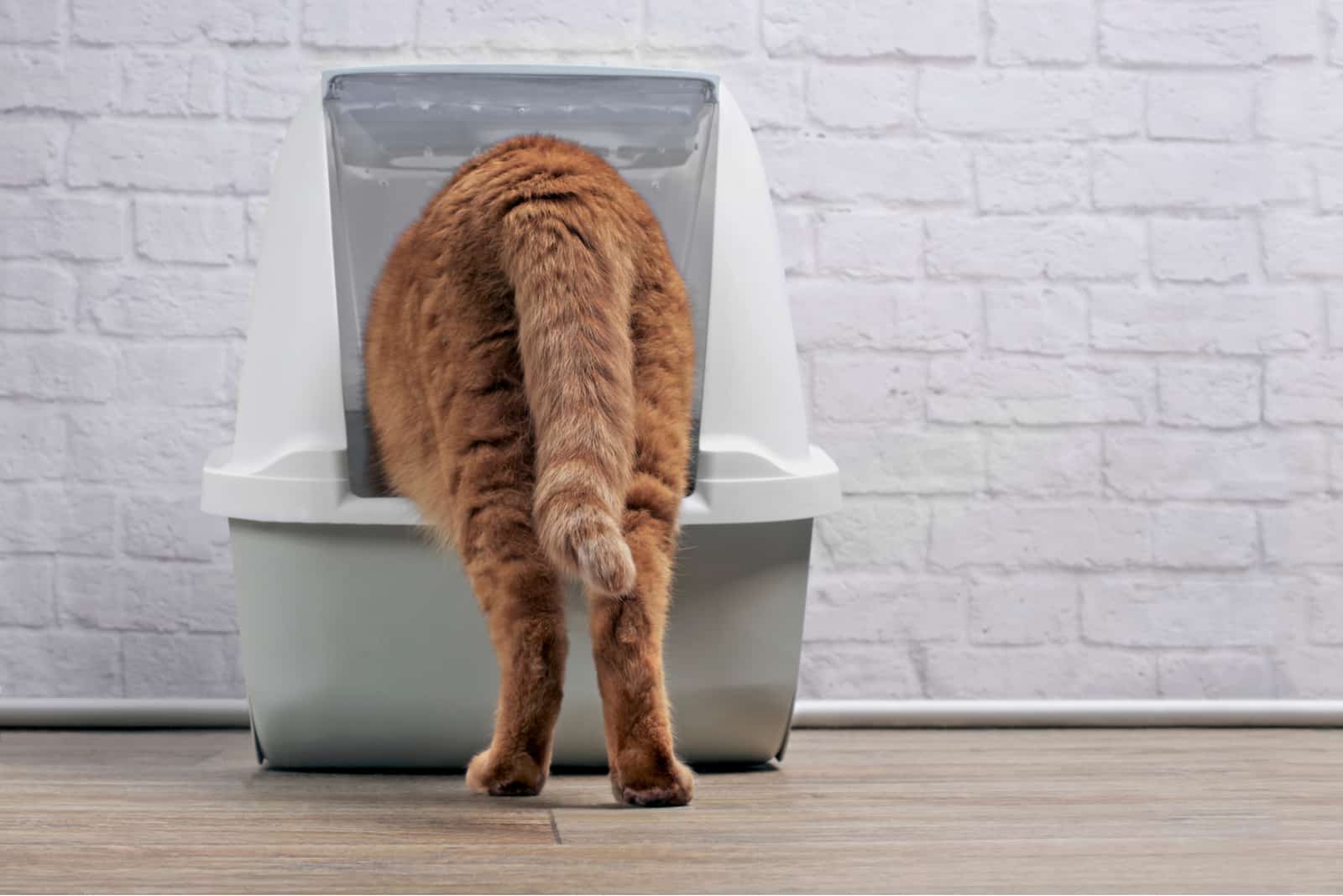
Although talking about the details of your cat’s poop can be a bit unpleasant, it is still a conversation that is needed if it helps to protect your pet’s health. Your cat’s wellbeing has to be the number one priority.
1. Hematochezia
Hematochezia is a medical term that describes bright red blood in (or on) the feces.
This is is mostly associated with problems (bleeding) of the organs of the lower gastrointestinal tract:
• Colon (also known as the large intestine)
• Rectum (end of the colon)
• Anus
• Anal glands
If your cat has issues with any of these parts of the lower GI tract, the bleeding will look like fresh, bright blood in the stool. This is because enzymes and bacteria have not had time to digest the blood.
Oftentimes, when a cat has bleeding of some part of the lower GI tract, it does not exhibit any other symptoms apart from bloody stool. This does not apply to issues affecting the anal glands, where other symptoms such as overgrooming and odor are usually present.
Although most of these issues are not life-threatening, they still require a veterinary check-up.
2. Melena
Melena is a medical term that describes black, tarry-looking stool. It is usually a symptom of a bleed in the upper gastrointestinal tract (GI tract).
Organs which can be affected:
• Esophagus
• Stomach
• Small intestine
The black color and strong odor are caused by enzymes and bacteria digesting the blood.
It is also possible that the respiratory tract could be the source of the bleeding and the cat is swallowing blood. For example, with chronic bleeding gums.
Stool containing dark blood is more of an emergency than stool containing fresh, bright blood.
If your cat has dark blood in its stool, please see a veterinarian as soon as possible.
Potential Causes Of Blood In Cat Stool
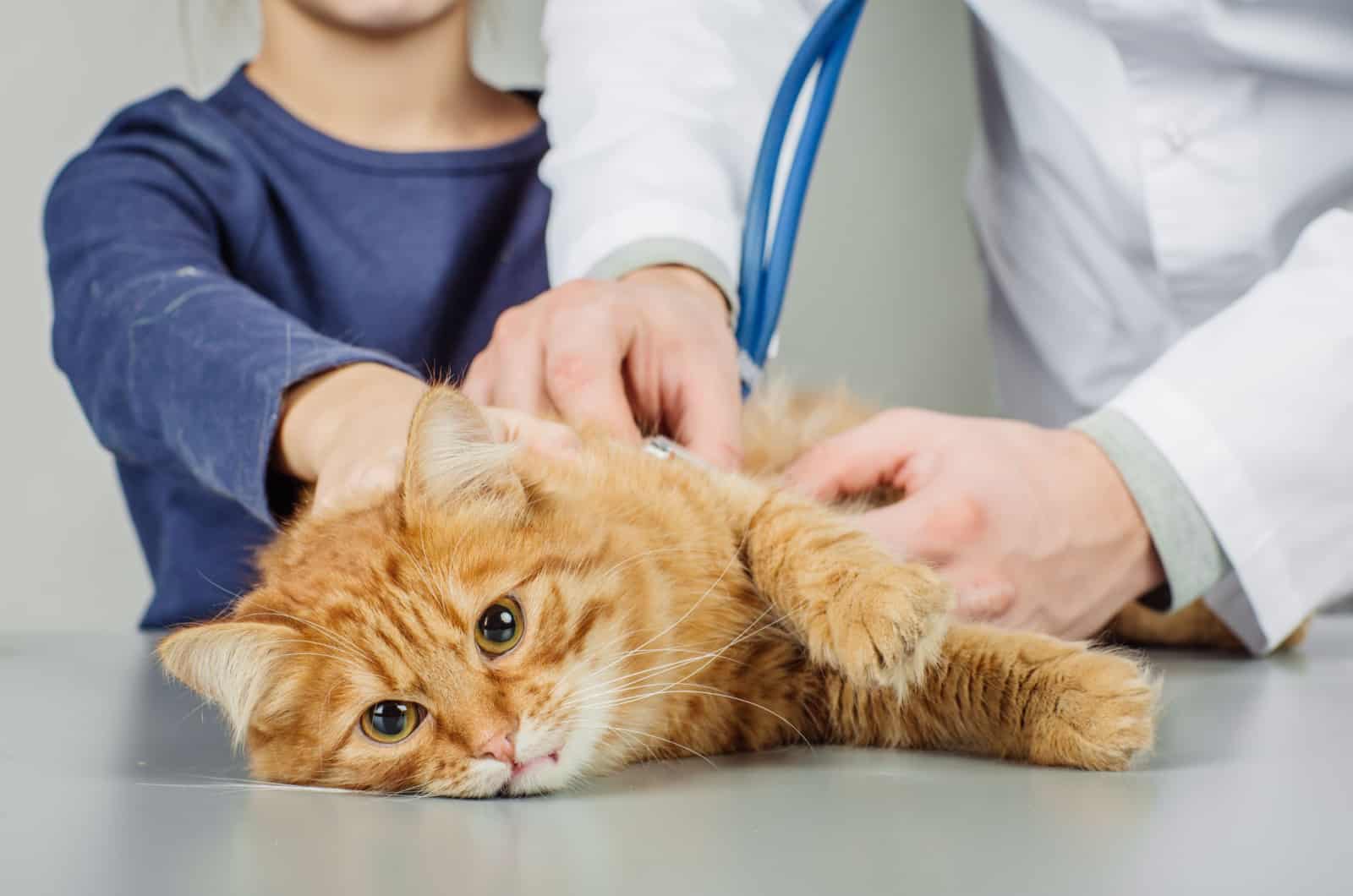
As there are a lot of potential causes of bloody cat stool, let’s explore them briefly one by one, and I will give you all the essential information.
These health issues are ordered alphabetically, not according to which is the most probable cause of your cat’s health issue.
Anal Sac Disease
Anal sacs, also known as the anal glands, are found at the cat’s rectal opening. They produce pheromones that cats use to mark their territory, and provide lubrication for the cat’s bowel movements.
The bacteria from the cat’s excrement can aggravate or infect these anal glands, resulting in the cat leaking brown fluid, as well as some blood and discharge. Cat poop smelling bad is also a common symptom.
Even a cat that is typically friendly may claw or attack you if you try to check your cat for this; anal sac conditions is extremely unpleasant and painful and the cat will try to keep you away from the affected area.
Bacterial Infection
An infection with Salmonella bacteria causes Salmonellosis. Ingesting substances (often food or water) that have been polluted with excrement can make any animal (or person) very unwell.
Symptoms of Salmonellosis include fever, low appetite, vomiting, diarrhea, bloody stools, enlarging of the lymph nodes, and unusual vaginal discharge..
Salmonellosis is actually relatively uncommon in cats. The majority of the time, a cat with Salmonella is only a carrier of the condition; it doesn’t feel unwell but can still spread the infection.
Cancer
The term cancer refers to a group of abnormal cells that keep multiplying and growing within the body, often forming a tumor.
Leiomyosarcoma is a cancer that grows in the smooth muscles of the intestines or stomach; it can cause various symptoms such as weight loss, lethargy, bloody stool, black stool, vomiting, diarrhea, as well as not eating much but acting normal.
In general, older cats are more likely than younger cats to develop cancer.
Food Allergy Or Eating Something Toxic (Such As Rat Poison)
A food allergy is when a protein found in a particular food triggers an immune system response (an allergic reaction).
Bloody stools can result from your cat eating something that doesn’t agree with it. This could be expired food, dead animals, trash, or even leftover human meals.
An allergic reaction to the food, a food intolerance, or ingesting parasites and poisons can both result in bloody stool.
Poison used to control rodents is particularly dangerous. Depending on the rodenticide, there may be different symptoms, but the most common ones are:
• Pale or bleeding gums
• Blood in the feces, urine, or vomit
• Lethargy or weakness
• Labored breathing
It is critical to consult a veterinarian right once if you suspect that your cat has consumed rat poison or any other type of potentially dangerous substance.
Inflammatory Bowel Disease (IBD)
Feline inflammatory bowel disease (IBD) is a dangerous and chronic condition that causes chronic inflammation of the gastrointestinal tract (GI tract). It usually affects senior cats, and in severe cases, euthanization of a cat with IBD may be recommended.
Depending on the location of the persistent inflammation and the type of immune cells involved, inflammatory bowel disease can take on a variety of distinct manifestations.
• Gastritis is a persistent inflammatory condition of the stomach .
• Enteritis is chronic inflammation of the small intestine.
• Chronic colon (large intestine) inflammation is known as colitis.
Symptoms of IBD include chronic vomiting, chronic diarrhea, bloody stool, weakness, loss of appetite, and weight loss.
Foreign Body
Although cats rarely consume things they shouldn’t, their curiosity can sometimes get the better of them. The ingestion of foreign objects can sometimes be a very serious issue.
If a cat manages to eat a sharp object, it can harm the digestive tract’s lining as it moves through the body. Internal bleeding and bloody stools can be results of this type of injury.
This may end in intestinal blockage. A blockage in the intestines is a very serious occurrence and it can be fatal. Pain and nausea are the most common initial signs of a blockage.
Your cat might require an immediate surgical procedure if they have a blockage. Vets can administer enemas to cats to aid with bowel movement. If this is the treatment plan, you should read up on what to expect after your cat has an enema.
Never wait to see what happens if you suspect your cat has eaten something they shouldn’t have. If you know how long it takes for a cat to digest food, you will be aware of any delayed litter box-business, which is a warning sign.
Intestinal Parasites

Cats frequently experience gastrointestinal (GI) parasitism, which can be caused by one-celled protozoa (such as coccidia or giardia protozoa as common causes) or worm-like parasites (such as roundworms).
Symptoms can include a dull coat, coughing, vomiting, diarrhea, mucus in stool, bloody stools, and loss of appetite.
Vomiting, diarrhea, anemia, and dehydration can seriously weaken a cat, making it more vulnerable to bacterial and viral infections, as well as other illnesses.
Related: At-Home Deworming For Cats: What You Should And Shouldn’t Use
Kidney Failure
Kidney failure is a medical condition where the cat’s kidneys stop functioning as they should.
One of the kidneys’ main functions is to filtrate the cat’s blood to remove harmful substances and waste products. When that does not happen, toxins can build up in blood, and this can have harmful consequences.
There is chronic kidney failure and acute kidney failure. Chronic kidney failure typically appears in elderly and middle-aged cats and takes months or even years to develop. Acute kidney failure appears suddenly, often over the course of a few days or weeks. Chronic renal issues are more challenging to treat.
You may notice a number of symptoms if your cat’s kidneys aren’t clearing waste from his or her body, including sudden lethargy and weakness, loss of appetite, diarrhea, blood in stool, vomiting (may contain blood), depression, etc.
Liver Failure
If a cat’s liver loses 75% or more of its function, it has acute liver failure, also referred to as hepatic failure.
This can be caused by infectious agents or toxins, inadequate fluid flow into the liver and its surrounding tissues, medicinal drugs or other substances that are harmful to the liver.
This condition affects the gastrointestinal tract, the renal system, the liver and gallbladder, the neurological system, and the blood.
Symptoms include weight loss, loss of appetite, jaundice, weakness, diarrhea, blood in stool, swollen abdomen, and depression.
Megacolon
Megacolon is a disorder in which cats experience persistent constipation. The cat’s colon is expanded in such a way that fecal matter builds up in the distended colon, instead of being forced into the rectum as it should be.
This happens when the nerves that supply the area with nutrients and oxygen do not work properly. The diameter of this expanded colon could be three to four times that of a typical cat.
When the cat does defecate regularly, the feces is oftentimes bloody.
Other clinical indicators of megacolon are straining to urinate, weight loss, fatigue, vomiting, and anorexia (lack of appetite). Physical examination may reveal that the cat is dehydrated, depressed or lethargic, and suffering from abdominal pain.
Pancreatitis
Pancreatitis is the medical term for inflammation of the pancreas. This was previously considered to be extremely uncommon in cats, but it is now more frequently diagnosed.
Several other illnesses in cats, including chronic intestinal disease, liver disease, gallbladder disease, and diabetes, are also linked to pancreatitis.
Typical clinical symptoms include vomiting, bloody stool, diarrhea, stomach pain, fever, tiredness, and decreased appetite. Acute shock or death could occur if the inflammation is severe.
Polyps
Polyps are benign (non-cancerous) tissue growths. They are typically found in young cats, especially young kittens.
The large intestine and the rectum can both contain colorectal polyps. These can occasionally be felt by probing or seen during a colonoscopy procedure, which uses a camera to look inside the cat’s rectum and colon.
Struggling to urinate, blood in the feces, and diarrhea are common symptoms. During a rectal examination, a veterinarian may feel a polyp, and its surface tends to bleed easily.
Viral Infection
Feline parvovirus is the cause of feline panleukopenia (FP), a very contagious viral illness that affects cats. The virus affects kittens particularly severely.
Cells that are rapidly reproducing and developing, like those in the intestines, bone marrow, and skin, are infected and killed by feline parvovirus..
This causes generalized depression, loss of appetite, high fever, lethargy, vomiting, severe diarrhea, nasal discharge, and dehydration. These are just some of the first outward symptoms the cat’s owner may notice.
Due to the damage caused to the cells lining the intestines, infected cats typically experience bloody diarrhea.
What Should You Do When You Notice Blood In Your Cat’s Stool?
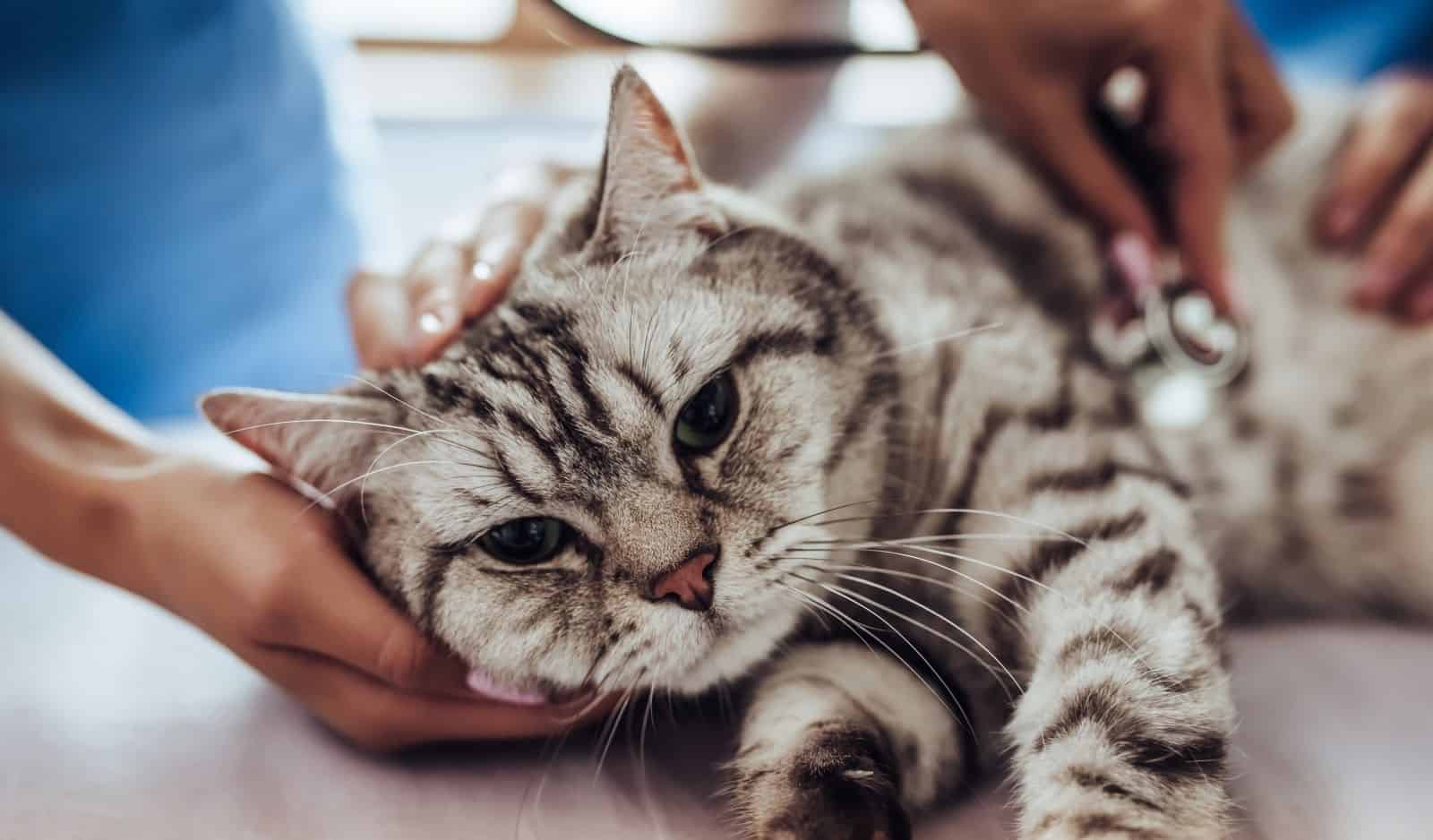
If you notice any blood in your cat’s stool, you need to visit the vet as soon as you can. While there are some causes that are not a serious health concern, others can be. There is no way what’s causing your pet’s issues until you visit the vet.
As they say, it’s better to be safe than sorry. Visiting the vet early on will mean a faster diagnosis and faster treatment, and that could potentially save you a lot of veterinary bills. It could even save your cat’s life.
Diagnosis
When you go to a doctor of veterinary medicine (DVM), they will ask you to give them your cat’s full medical history (if they don’t have records of it) and explain the circumstances of your visit – they will ask when you noticed blood in the stool, whether it is a regular occurance for your cat, if there are any other symptoms, etc.
After that, the vet will carry out a complete medical exam, probably including a rectal exam. Lab tests are almost always included in the diagnostic process, so blood work and urinalysis will be performed as well. Stool samples will be needed to be examined as well.
Depending on what your vet suspects the underlying issue is, they may do some more disease-specific tests.
There is also a high chance they will do some exploratory surgery or an endoscopy, as well as performing X rays test to check for potential causes of constipation.
Either way, your vet will try their best to find the underlying cause of your cat’s bloody stool.
Treatment
The treatment of bloody stool depends on what’s underlying cause may be. When the root issue is diagnosed, then the treatment plan will be discussed and determined. Therefore, proper diagnosis is the key first step in making your cat better.
[table id=239 /]
Why Is My Cat Pooping Blood But Acting Normal?
A lot of us often forget the wild ancestry of our pet cats. They aren’t just a furry bundle of joy – they are the descendents of wild animals that constantly had to think about their survival. They are still hard-wired to act in a way that keeps them safe from danger.
One survival technique is making sure that a potential predator does not notice you’re not doing well! If a predator observes that the prey is weak, it will be more willing to attack it and will probably be successful at it.
Therefore, cats have a strong instinct to hide their condition if they’re not feeling well; they don’t want to be easy prey. Although domesticated cats, especially house cats, have no prey to worry about – they simply can’t help it, the defensive instinct is still strong.
Some instinctive wild-cat behaviors have remained within our domesticated cats, and there is nothing we can do about it. It’s our job to notice the symptoms they cannot hide.
This is why we have to be aware of abnormal stool or urine, such as cat poop being half-firm, half-soft, having foamy urine, or even leaving blood drops behind, and many other concerning signs.
FAQ
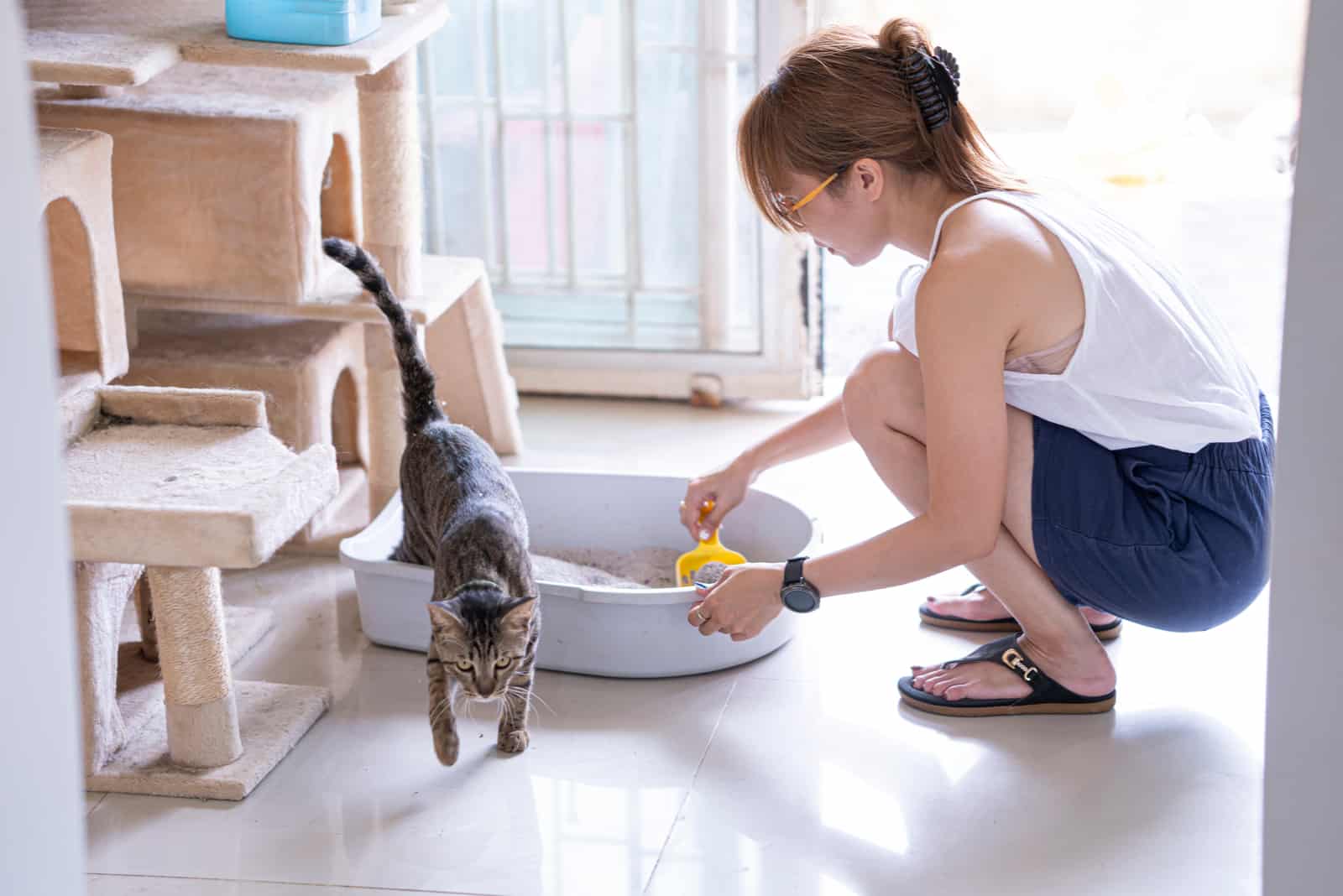
Is Blood In Cat Poop An Emergency?
If your cat’s poop contains black blood, this is a real emergency, as it suggests bleeding in the upper part of the gastrointestinal tract. If your cat’s stool contains bright red blood, it is still an emergency, but not as serious a red flag as black blood.
Either way, you should go to the veterinarian’s office as soon as you can. Do not try any home remedies, as your pet might be battling something very serious (such as cancer, inflammation of the colon, or intestinal tract polyps)
Is Blood In Cat Poop A Result Of Severe Illness?
Blood in cat poop is not always a symptom of a very severe, life-threatening illness. Some causes of bloody poop are easy to manage and can be resolved in a short period of time. However, the cat could be dealing with a severe health issue that is more difficult to manage and so should be checked out by a vet as soon as possible.
Is It Safe To Let My Cat Outside If There Is Blood In His Stool?
There is no reason not to let your cat wander around the house or garden if they are strong enough and not experiencing other symptoms, as long as it will not negatively impact your cat’s health. However, you should take your pet to the veterinarian’s office the first chance you get.
What Are The Signs Of A Cat Having An Obstruction?
Intestinal blockage, or obstruction, includes the following symptoms: vomiting, diarrhea (which may contain blood), appetite loss, weakness, straining to defecate, abdominal pain, etc. When a cat is entirely blocked, they may try to use the litter box but nothing will come out.
If your cat has other symptoms, seems very unwell, or still cannot defecate properly after a day or two, go to the vet immediately.
In Conclusion
Spotting blood in cat stool when the cat is otherwise acting normal can be baffling for cat owners. This is something cats do as they don’t want to show their health issues. It’s just part of their defensive instinct. However, bloody stool is something they cannot hide, and you should monitor your pet for any other symptoms it might be experiencing.
As you can see, there are a variety of explanations for blood in a cat’s feces, some of which are minor, some of which are cause for alarm, and some of which are serious emergencies.
Without a veterinary exam, it is impossible to pinpoint the cause of the blood you have observed in your cat’s feces. Call your veterinarian to make an appointment for your cat to be seen if you notice or suspect there is blood in her feces.

